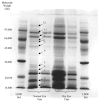Single eye analysis and contralateral eye comparison of tear proteins in normal and dry eye model rabbits by MALDI-ToF mass spectrometry using wax-coated target plates
- PMID: 17211596
- PMCID: PMC2268083
- DOI: 10.1007/s00216-006-1018-9
Single eye analysis and contralateral eye comparison of tear proteins in normal and dry eye model rabbits by MALDI-ToF mass spectrometry using wax-coated target plates
Abstract
A study of rabbit tear protein expression in a dry eye rabbit model was performed to determine if a pattern in expressed proteins could be identified. The uniqueness of the model allows the comparison of normal (control) eye tear protein expression with surgically induced dry eye tear protein expression in individual animals. The sensitivity of the method allows for single eye analysis. One-dimensional mini-gel electrophoresis of the tear proteins did not show substantial differences between band patterns of the normal versus the dry eye, but was used to assess the molecular weight ranges of the major proteins. Specific assignments of some of the predominant proteins were obtained by tandem mass spectrometry (MS) which showed that the lower molecular weight lipid-binding proteins (approximately 10 kDa to 36 kDa) constitute a considerable amount of the observed protein, followed in lesser quantities by the transferrins which have higher molecular weights ranging from 70 kDa to 85 kDa. Enhancement of matrix-assisted laser desorption/ionization time-of-flight (MALDI-ToF) MS linear mode analysis of intact proteins in tear fluid was demonstrated through the use of wax-coated MALDI plates and spot washing. MALDI-ToF MS analysis of the expressed tear proteins illustrates that differences between normal eye tear and dry eye tear protein content are manifested in changes in the lower molecular weight lipid-binding proteins such as lipophilin which exhibits an increase in concentration in the dry eye, and beta-2 microglobulin which undergoes a decrease.
Figures







Similar articles
-
Identification and comparison of the polar phospholipids in normal and dry eye rabbit tears by MALDI-TOF mass spectrometry.Invest Ophthalmol Vis Sci. 2006 Aug;47(8):3330-8. doi: 10.1167/iovs.05-0756. Invest Ophthalmol Vis Sci. 2006. PMID: 16877399 Free PMC article.
-
SELDI-TOF-MS ProteinChip array profiling of tears from patients with dry eye.Invest Ophthalmol Vis Sci. 2005 Mar;46(3):863-76. doi: 10.1167/iovs.04-0448. Invest Ophthalmol Vis Sci. 2005. PMID: 15728542
-
Alterations in the tear proteome of dry eye patients--a matter of the clinical phenotype.Invest Ophthalmol Vis Sci. 2013 Mar 28;54(3):2385-92. doi: 10.1167/iovs.11-8751. Invest Ophthalmol Vis Sci. 2013. PMID: 23425692
-
Electrophoresis of tear proteins as a new diagnostic tool for two high risk groups for dry eye: computer users and contact lens wearers.J Med Life. 2011 Aug 15;4(3):228-33. Epub 2011 Aug 25. J Med Life. 2011. PMID: 22567044 Free PMC article. Review.
-
Critical role of mass spectrometry proteomics in tear biomarker discovery for multifactorial ocular diseases (Review).Int J Mol Med. 2021 May;47(5):83. doi: 10.3892/ijmm.2021.4916. Epub 2021 Mar 24. Int J Mol Med. 2021. PMID: 33760148 Free PMC article. Review.
Cited by
-
Investigation of the human tear film proteome using multiple proteomic approaches.Mol Vis. 2008 Mar 7;14:456-70. Mol Vis. 2008. PMID: 18334958 Free PMC article.
-
Patient stratification in clinical glaucoma trials using the individual tear proteome.Sci Rep. 2018 Aug 13;8(1):12038. doi: 10.1038/s41598-018-30369-x. Sci Rep. 2018. PMID: 30104599 Free PMC article.
-
The influence of sample preparation and replicate analyses on HeLa Cell phosphoproteome coverage.J Proteome Res. 2008 Jun;7(6):2215-21. doi: 10.1021/pr700575m. Epub 2008 Apr 16. J Proteome Res. 2008. PMID: 18412383 Free PMC article.
-
Lacrimal proline rich 4 (LPRR4) protein in the tear fluid is a potential biomarker of dry eye syndrome.PLoS One. 2012;7(12):e51979. doi: 10.1371/journal.pone.0051979. Epub 2012 Dec 18. PLoS One. 2012. PMID: 23272196 Free PMC article.
References
-
- Holly FJ, Lemp MA. Int Ophthalmol Clin. 1973;13:29. - PubMed
-
- Ellison SA, Jacobson M, Levine MJ. Lacrimal and salivary proteins. Immunol eye, workshop 3: immunological aspects of ocular disease: infection, inflammation, and allergy; 1980; 1981. Meeting Date.
-
- Frey WH, DeSota-Johnson D, Hoffman C, McCall JT. Am J Ophthalmol. 1981;92:559. - PubMed
-
- Holly FJ, Hong BS. Am J Optom Physiol Opt. 1982;59:43. - PubMed
-
- Gachon AM, Richard J, Dastugue B. Curr Eye Res. 1982;2:301. - PubMed
Publication types
MeSH terms
Substances
Grants and funding
LinkOut - more resources
Full Text Sources
Medical
Research Materials

